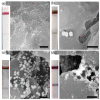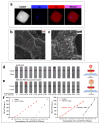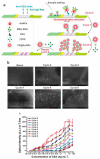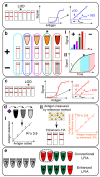Post-Assay Chemical Enhancement for Highly Sensitive Lateral Flow Immunoassays: A Critical Review
- PMID: 37754100
- PMCID: PMC10526817
- DOI: 10.3390/bios13090866
Post-Assay Chemical Enhancement for Highly Sensitive Lateral Flow Immunoassays: A Critical Review
Abstract
Lateral flow immunoassay (LFIA) has found a broad application for testing in point-of-care (POC) settings. LFIA is performed using test strips-fully integrated multimembrane assemblies containing all reagents for assay performance. Migration of liquid sample along the test strip initiates the formation of labeled immunocomplexes, which are detected visually or instrumentally. The tradeoff of LFIA's rapidity and user-friendliness is its relatively low sensitivity (high limit of detection), which restricts its applicability for detecting low-abundant targets. An increase in LFIA's sensitivity has attracted many efforts and is often considered one of the primary directions in developing immunochemical POC assays. Post-assay enhancements based on chemical reactions facilitate high sensitivity. In this critical review, we explain the performance of post-assay chemical enhancements, discuss their advantages, limitations, compared limit of detection (LOD) improvements, and required time for the enhancement procedures. We raise concerns about the performance of enhanced LFIA and discuss the bottlenecks in the existing experiments. Finally, we suggest the experimental workflow for step-by-step development and validation of enhanced LFIA. This review summarizes the state-of-art of LFIA with chemical enhancement, offers ways to overcome existing limitations, and discusses future outlooks for highly sensitive testing in POC conditions.
Keywords: antibodies; highly sensitive detection; immunochromatography; nanoparticles; nanozymes; point-of-care testing; signal amplification.
Conflict of interest statement
The authors declare no conflict of interest.
Figures














Similar articles
-
One-step copper deposition-induced signal amplification for multiplex bacterial infection diagnosis on a lateral flow immunoassay device.Biosens Bioelectron. 2025 Jan 1;267:116849. doi: 10.1016/j.bios.2024.116849. Epub 2024 Oct 11. Biosens Bioelectron. 2025. PMID: 39406071
-
Popcorn-like bimetallic palladium/platinum exhibiting enhanced peroxidase-like activity for signal enhancement in lateral flow immunoassay.Anal Chim Acta. 2024 Jun 22;1309:342698. doi: 10.1016/j.aca.2024.342698. Epub 2024 May 7. Anal Chim Acta. 2024. PMID: 38772661
-
Electrophoresis-Assisted Multilayer Assembly of Nanoparticles for Sensitive Lateral Flow Immunoassay.Angew Chem Int Ed Engl. 2023 Jan 9;62(2):e202215548. doi: 10.1002/anie.202215548. Epub 2022 Dec 7. Angew Chem Int Ed Engl. 2023. PMID: 36357330
-
Recent Advances in Quantum Dot-Based Lateral Flow Immunoassays for the Rapid, Point-of-Care Diagnosis of COVID-19.Biosensors (Basel). 2023 Aug 3;13(8):786. doi: 10.3390/bios13080786. Biosensors (Basel). 2023. PMID: 37622872 Free PMC article. Review.
-
SERS Based Lateral Flow Immunoassay for Point-of-Care Detection of SARS-CoV-2 in Clinical Samples.ACS Appl Bio Mater. 2021 Apr 19;4(4):2974-2995. doi: 10.1021/acsabm.1c00102. Epub 2021 Mar 17. ACS Appl Bio Mater. 2021. PMID: 35014387 Review.
Cited by
-
Lateral Flow Immunosensing of Salmonella Typhimurium Cells in Milk: Comparing Three Sequences of Interactions.Microorganisms. 2024 Dec 11;12(12):2555. doi: 10.3390/microorganisms12122555. Microorganisms. 2024. PMID: 39770758 Free PMC article.
-
Ultrasensitive Lateral Flow Immunoassay of Fluoroquinolone Antibiotic Gatifloxacin Using Au@Ag Nanoparticles as a Signal-Enhancing Label.Biosensors (Basel). 2024 Dec 6;14(12):598. doi: 10.3390/bios14120598. Biosensors (Basel). 2024. PMID: 39727863 Free PMC article.
-
High Specific and Rapid Detection of Cannabidiol by Gold Nanoparticle-Based Paper Sensor.Biosensors (Basel). 2023 Oct 28;13(11):960. doi: 10.3390/bios13110960. Biosensors (Basel). 2023. PMID: 37998135 Free PMC article.
-
Heavy Metal Ion Detection Based on Lateral Flow Assay Technology: Principles and Applications.Biosensors (Basel). 2025 Jul 7;15(7):438. doi: 10.3390/bios15070438. Biosensors (Basel). 2025. PMID: 40710088 Free PMC article. Review.
-
Highly Sensitive Immunochromatographic Detection of Porcine Myoglobin as Biomarker for Meat Authentication Using Prussian Blue Nanozyme.Foods. 2023 Nov 24;12(23):4252. doi: 10.3390/foods12234252. Foods. 2023. PMID: 38231679 Free PMC article.
References
Publication types
MeSH terms
Grants and funding
LinkOut - more resources
Full Text Sources

